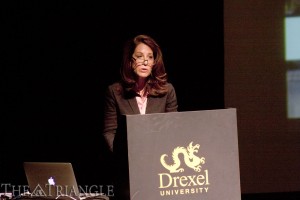The Farajollah and Maryam Badie Arfaa Lecture Series, a program sponsored by Drexel’s Department of Architecture and Interiors, hosted a lecture titled “The New Currency of Space: What’s Influencing the Design of Environments Today” April 9 in the Mandell Theater.
Robin Klehr Avia, the regional managing principal and chair of the board of directors at Gensler, was invited to discuss the evolution and future of architecture as the final component of the 2012-13 Arfaa Lecture Series. Farajollah Arfaa, former department head and professor, endowed the series 19 years ago.
Gensler is one of the largest architecture, design and planning firms worldwide, consisting of over 3,500 professionals in 43 global locations. Avia’s impressive work has allowed her to grow from a junior designer at Gensler in 1980 to an esteemed member of the executive committee today. She oversees offices in New York, New Jersey, Massachusetts, Sao Paulo, Costa Rica and Canada.
After she was introduced by Debra Ruben, assistant professor in the Department of Architecture and Interiors, Avia clarified that she would not be discussing “Jupiter adopting Europe” or other outer-space-related material. Instead, she explained that her focus would be on the principles of design philosophy at Gensler and on projects that illustrate their application.
A short video kicked off the lecture by providing a foundation of the changing demographics, trends and new influences relevant to architecture and design. Avia then emphasized evolution, innovation and exploration as the three “insights” to be focused on in the field of architecture and design today.
“The world is rapidly changing, and the role of design is more important than ever to create environments that align and lead with the cultural shifts that we see happening today. It’s not enough just to create great work, but architects and designers are expected to be strategic thinkers. The design process is being used to lead, investigate, problem solve and vision for our clients, and design thinking’s in higher demand than ever before,” she said.
She explained the importance of designers understanding not only the relationship between their clients’ businesses and workplaces but also anticipating how clients’ use of space will need to adapt and evolve as time progresses.
“Staying relevant is the most important aspect,” she said.
For example, Gensler designed and constructed the JetBlue Airways Terminal 5 at John F. Kennedy Airport in 2008 “to address contemporary travel needs from functional, financial and experiential perspective.” The terminal’s purpose can be found in its name, “Shared Destination.” Because the global economy increasingly requires professionals to travel, Gensler saw the need to create terminals designed for leisure, socialization and productivity instead of a simple waiting room. Terminal 5, Gensler said, was designed “to meet the dynamic needs of today’s travelers and the airport’s stringent budget requirements.”
Architects and designers, Avia explained, are expected to create “breakthrough ideas, not just design spaces.” She encouraged doing so by using “urban” concepts for inspiration.
“Mixed-used programming and urban planning are fundamental to all our projects, especially our workplace, office and corporate interior design. The power of urban provides a prototype for how learning and collaboration can be driven by dense, diverse environments,” Avia said.
Avia described how utilizing urban concepts is what led to Gensler’s successful work for Facebook and will continue to be explored. She called Facebook’s reputation as a “creative company” the reason its design excluded company logos and colors. Instead, Facebook’s office encourages employees to flourish and create in their own personalized spaces. Avia described Gensler’s work on the project as “all about creating a vibrant urban stream to bring employees together and connect employees with bridges and stairs to facilitate cross-communication and constant movement.”
Lifestyle has become a driving force for design, and place making engages people and creates memorable experiences. In this sense, Avia explained, architecture and design are important and relevant to everyone.
Michael Patterson, a third-year architecture student, expressed that he “thought the lecture was well executed”; however, “it was a synthesis of logics that we already have learned as students.”
Similarly, architecture student Brian Nunziato, currently in his fifth year of the six-year program, felt the lecture was similar to “a generic corporate presentation, perhaps one they show to clients.” However, he said he “liked the consideration of a non-typical workplace with a focus on health and collaboration with the potential for greater application of more contemporary ideas.” He continued, “Sitting at a desk for eight hours is not fun, and [Avia] showed examples of how to change this in the workplace.”
Mark Brack, who coordinated the Arfaa program and is an associate professor at Drexel, said, “Through Mr. Arfaa’s endowment, we have been able to bring some of the world’s leading architects, designers and historians in the field to Drexel so students can be exposed to the experiences and relevant content from [esteemed] professionals.”
“This is one of the only programs at Drexel that has consistently brought in speakers for a specific department for almost 20 years.”Brack said that Avia was invited specifically because of her expertise in interiors, public spaces and designing corporate headquarters, in addition to her extensive work at Gensler.



